Yifan Gao
Dino U-Net: Exploiting High-Fidelity Dense Features from Foundation Models for Medical Image Segmentation
Aug 28, 2025Abstract:Foundation models pre-trained on large-scale natural image datasets offer a powerful paradigm for medical image segmentation. However, effectively transferring their learned representations for precise clinical applications remains a challenge. In this work, we propose Dino U-Net, a novel encoder-decoder architecture designed to exploit the high-fidelity dense features of the DINOv3 vision foundation model. Our architecture introduces an encoder built upon a frozen DINOv3 backbone, which employs a specialized adapter to fuse the model's rich semantic features with low-level spatial details. To preserve the quality of these representations during dimensionality reduction, we design a new fidelity-aware projection module (FAPM) that effectively refines and projects the features for the decoder. We conducted extensive experiments on seven diverse public medical image segmentation datasets. Our results show that Dino U-Net achieves state-of-the-art performance, consistently outperforming previous methods across various imaging modalities. Our framework proves to be highly scalable, with segmentation accuracy consistently improving as the backbone model size increases up to the 7-billion-parameter variant. The findings demonstrate that leveraging the superior, dense-pretrained features from a general-purpose foundation model provides a highly effective and parameter-efficient approach to advance the accuracy of medical image segmentation. The code is available at https://github.com/yifangao112/DinoUNet.
PRISM: A Framework Harnessing Unsupervised Visual Representations and Textual Prompts for Explainable MACE Survival Prediction from Cardiac Cine MRI
Aug 26, 2025Abstract:Accurate prediction of major adverse cardiac events (MACE) remains a central challenge in cardiovascular prognosis. We present PRISM (Prompt-guided Representation Integration for Survival Modeling), a self-supervised framework that integrates visual representations from non-contrast cardiac cine magnetic resonance imaging with structured electronic health records (EHRs) for survival analysis. PRISM extracts temporally synchronized imaging features through motion-aware multi-view distillation and modulates them using medically informed textual prompts to enable fine-grained risk prediction. Across four independent clinical cohorts, PRISM consistently surpasses classical survival prediction models and state-of-the-art (SOTA) deep learning baselines under internal and external validation. Further clinical findings demonstrate that the combined imaging and EHR representations derived from PRISM provide valuable insights into cardiac risk across diverse cohorts. Three distinct imaging signatures associated with elevated MACE risk are uncovered, including lateral wall dyssynchrony, inferior wall hypersensitivity, and anterior elevated focus during diastole. Prompt-guided attribution further identifies hypertension, diabetes, and smoking as dominant contributors among clinical and physiological EHR factors.
SessionIntentBench: A Multi-task Inter-session Intention-shift Modeling Benchmark for E-commerce Customer Behavior Understanding
Jul 27, 2025Abstract:Session history is a common way of recording user interacting behaviors throughout a browsing activity with multiple products. For example, if an user clicks a product webpage and then leaves, it might because there are certain features that don't satisfy the user, which serve as an important indicator of on-the-spot user preferences. However, all prior works fail to capture and model customer intention effectively because insufficient information exploitation and only apparent information like descriptions and titles are used. There is also a lack of data and corresponding benchmark for explicitly modeling intention in E-commerce product purchase sessions. To address these issues, we introduce the concept of an intention tree and propose a dataset curation pipeline. Together, we construct a sibling multimodal benchmark, SessionIntentBench, that evaluates L(V)LMs' capability on understanding inter-session intention shift with four subtasks. With 1,952,177 intention entries, 1,132,145 session intention trajectories, and 13,003,664 available tasks mined using 10,905 sessions, we provide a scalable way to exploit the existing session data for customer intention understanding. We conduct human annotations to collect ground-truth label for a subset of collected data to form an evaluation gold set. Extensive experiments on the annotated data further confirm that current L(V)LMs fail to capture and utilize the intention across the complex session setting. Further analysis show injecting intention enhances LLMs' performances.
A Composite Alignment-Aware Framework for Myocardial Lesion Segmentation in Multi-sequence CMR Images
Jul 16, 2025Abstract:Accurate segmentation of myocardial lesions from multi-sequence cardiac magnetic resonance imaging is essential for cardiac disease diagnosis and treatment planning. However, achieving optimal feature correspondence is challenging due to intensity variations across modalities and spatial misalignment caused by inconsistent slice acquisition protocols. We propose CAA-Seg, a composite alignment-aware framework that addresses these challenges through a two-stage approach. First, we introduce a selective slice alignment method that dynamically identifies and aligns anatomically corresponding slice pairs while excluding mismatched sections, ensuring reliable spatial correspondence between sequences. Second, we develop a hierarchical alignment network that processes multi-sequence features at different semantic levels, i.e., local deformation correction modules address geometric variations in low-level features, while global semantic fusion blocks enable semantic fusion at high levels where intensity discrepancies diminish. We validate our method on a large-scale dataset comprising 397 patients. Experimental results show that our proposed CAA-Seg achieves superior performance on most evaluation metrics, with particularly strong results in myocardial infarction segmentation, representing a substantial 5.54% improvement over state-of-the-art approaches. The code is available at https://github.com/yifangao112/CAA-Seg.
LRMR: LLM-Driven Relational Multi-node Ranking for Lymph Node Metastasis Assessment in Rectal Cancer
Jul 15, 2025Abstract:Accurate preoperative assessment of lymph node (LN) metastasis in rectal cancer guides treatment decisions, yet conventional MRI evaluation based on morphological criteria shows limited diagnostic performance. While some artificial intelligence models have been developed, they often operate as black boxes, lacking the interpretability needed for clinical trust. Moreover, these models typically evaluate nodes in isolation, overlooking the patient-level context. To address these limitations, we introduce LRMR, an LLM-Driven Relational Multi-node Ranking framework. This approach reframes the diagnostic task from a direct classification problem into a structured reasoning and ranking process. The LRMR framework operates in two stages. First, a multimodal large language model (LLM) analyzes a composite montage image of all LNs from a patient, generating a structured report that details ten distinct radiological features. Second, a text-based LLM performs pairwise comparisons of these reports between different patients, establishing a relative risk ranking based on the severity and number of adverse features. We evaluated our method on a retrospective cohort of 117 rectal cancer patients. LRMR achieved an area under the curve (AUC) of 0.7917 and an F1-score of 0.7200, outperforming a range of deep learning baselines, including ResNet50 (AUC 0.7708). Ablation studies confirmed the value of our two main contributions: removing the relational ranking stage or the structured prompting stage led to a significant performance drop, with AUCs falling to 0.6875 and 0.6458, respectively. Our work demonstrates that decoupling visual perception from cognitive reasoning through a two-stage LLM framework offers a powerful, interpretable, and effective new paradigm for assessing lymph node metastasis in rectal cancer.
UniConv: Unifying Retrieval and Response Generation for Large Language Models in Conversations
Jul 09, 2025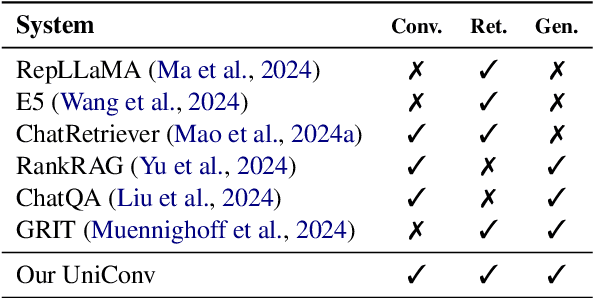
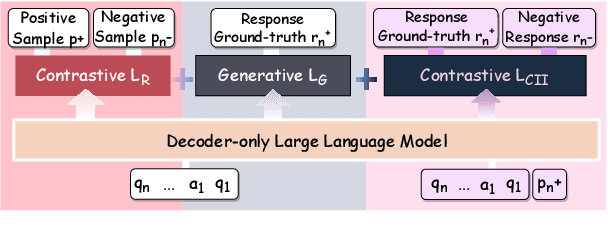
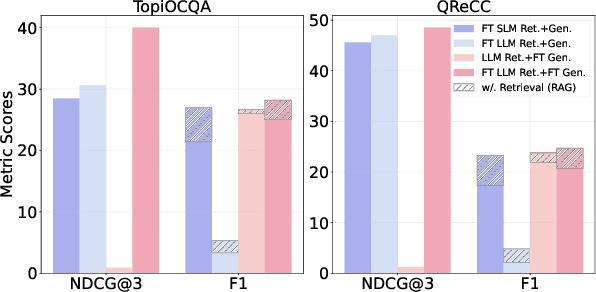
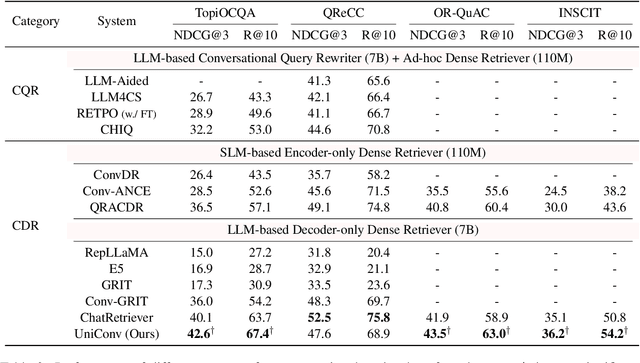
Abstract:The rapid advancement of conversational search systems revolutionizes how information is accessed by enabling the multi-turn interaction between the user and the system. Existing conversational search systems are usually built with two different models. This separation restricts the system from leveraging the intrinsic knowledge of the models simultaneously, which cannot ensure the effectiveness of retrieval benefiting the generation. The existing studies for developing unified models cannot fully address the aspects of understanding conversational context, managing retrieval independently, and generating responses. In this paper, we explore how to unify dense retrieval and response generation for large language models in conversation. We conduct joint fine-tuning with different objectives and design two mechanisms to reduce the inconsistency risks while mitigating data discrepancy. The evaluations on five conversational search datasets demonstrate that our unified model can mutually improve both tasks and outperform the existing baselines.
PersonaAgent: When Large Language Model Agents Meet Personalization at Test Time
Jun 06, 2025Abstract:Large Language Model (LLM) empowered agents have recently emerged as advanced paradigms that exhibit impressive capabilities in a wide range of domains and tasks. Despite their potential, current LLM agents often adopt a one-size-fits-all approach, lacking the flexibility to respond to users' varying needs and preferences. This limitation motivates us to develop PersonaAgent, the first personalized LLM agent framework designed to address versatile personalization tasks. Specifically, PersonaAgent integrates two complementary components - a personalized memory module that includes episodic and semantic memory mechanisms; a personalized action module that enables the agent to perform tool actions tailored to the user. At the core, the persona (defined as unique system prompt for each user) functions as an intermediary: it leverages insights from personalized memory to control agent actions, while the outcomes of these actions in turn refine the memory. Based on the framework, we propose a test-time user-preference alignment strategy that simulate the latest n interactions to optimize the persona prompt, ensuring real-time user preference alignment through textual loss feedback between simulated and ground-truth responses. Experimental evaluations demonstrate that PersonaAgent significantly outperforms other baseline methods by not only personalizing the action space effectively but also scaling during test-time real-world applications. These results underscore the feasibility and potential of our approach in delivering tailored, dynamic user experiences.
Aligning Large Language Models with Implicit Preferences from User-Generated Content
Jun 04, 2025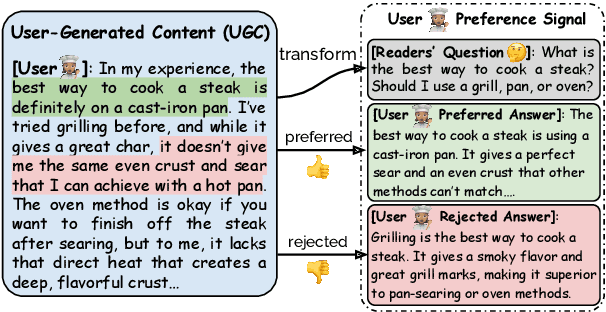
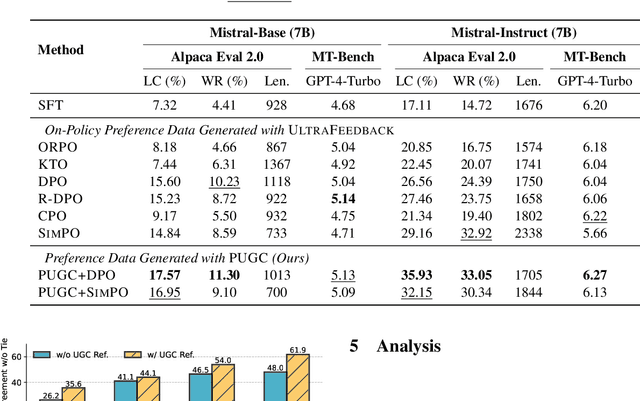
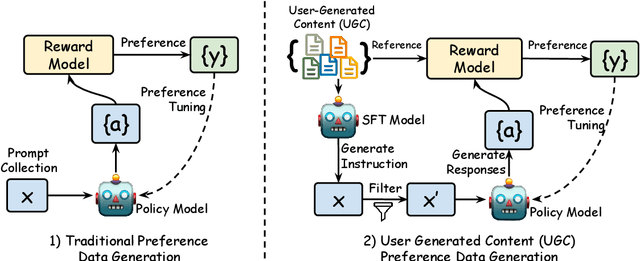

Abstract:Learning from preference feedback is essential for aligning large language models (LLMs) with human values and improving the quality of generated responses. However, existing preference learning methods rely heavily on curated data from humans or advanced LLMs, which is costly and difficult to scale. In this work, we present PUGC, a novel framework that leverages implicit human Preferences in unlabeled User-Generated Content (UGC) to generate preference data. Although UGC is not explicitly created to guide LLMs in generating human-preferred responses, it often reflects valuable insights and implicit preferences from its creators that has the potential to address readers' questions. PUGC transforms UGC into user queries and generates responses from the policy model. The UGC is then leveraged as a reference text for response scoring, aligning the model with these implicit preferences. This approach improves the quality of preference data while enabling scalable, domain-specific alignment. Experimental results on Alpaca Eval 2 show that models trained with DPO and PUGC achieve a 9.37% performance improvement over traditional methods, setting a 35.93% state-of-the-art length-controlled win rate using Mistral-7B-Instruct. Further studies highlight gains in reward quality, domain-specific alignment effectiveness, robustness against UGC quality, and theory of mind capabilities. Our code and dataset are available at https://zhaoxuan.info/PUGC.github.io/
Gradient Boosting Decision Tree with LSTM for Investment Prediction
May 29, 2025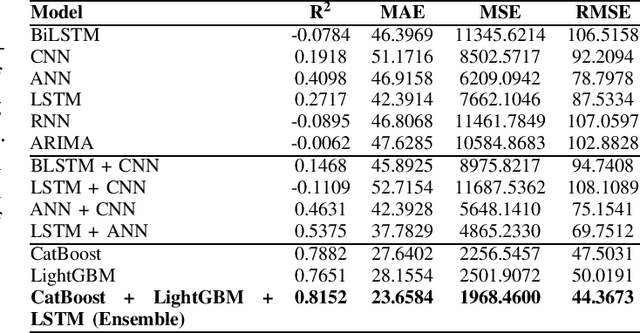
Abstract:This paper proposes a hybrid framework combining LSTM (Long Short-Term Memory) networks with LightGBM and CatBoost for stock price prediction. The framework processes time-series financial data and evaluates performance using seven models: Artificial Neural Networks (ANNs), Convolutional Neural Networks (CNNs), Bidirectional LSTM (BiLSTM), vanilla LSTM, XGBoost, LightGBM, and standard Neural Networks (NNs). Key metrics, including MAE, R-squared, MSE, and RMSE, are used to establish benchmarks across different time scales. Building on these benchmarks, we develop an ensemble model that combines the strengths of sequential and tree-based approaches. Experimental results show that the proposed framework improves accuracy by 10 to 15 percent compared to individual models and reduces error during market changes. This study highlights the potential of ensemble methods for financial forecasting and provides a flexible design for integrating new machine learning techniques.
SETransformer: A Hybrid Attention-Based Architecture for Robust Human Activity Recognition
May 25, 2025Abstract:Human Activity Recognition (HAR) using wearable sensor data has become a central task in mobile computing, healthcare, and human-computer interaction. Despite the success of traditional deep learning models such as CNNs and RNNs, they often struggle to capture long-range temporal dependencies and contextual relevance across multiple sensor channels. To address these limitations, we propose SETransformer, a hybrid deep neural architecture that combines Transformer-based temporal modeling with channel-wise squeeze-and-excitation (SE) attention and a learnable temporal attention pooling mechanism. The model takes raw triaxial accelerometer data as input and leverages global self-attention to capture activity-specific motion dynamics over extended time windows, while adaptively emphasizing informative sensor channels and critical time steps. We evaluate SETransformer on the WISDM dataset and demonstrate that it significantly outperforms conventional models including LSTM, GRU, BiLSTM, and CNN baselines. The proposed model achieves a validation accuracy of 84.68\% and a macro F1-score of 84.64\%, surpassing all baseline architectures by a notable margin. Our results show that SETransformer is a competitive and interpretable solution for real-world HAR tasks, with strong potential for deployment in mobile and ubiquitous sensing applications.
 Add to Chrome
Add to Chrome Add to Firefox
Add to Firefox Add to Edge
Add to Edge